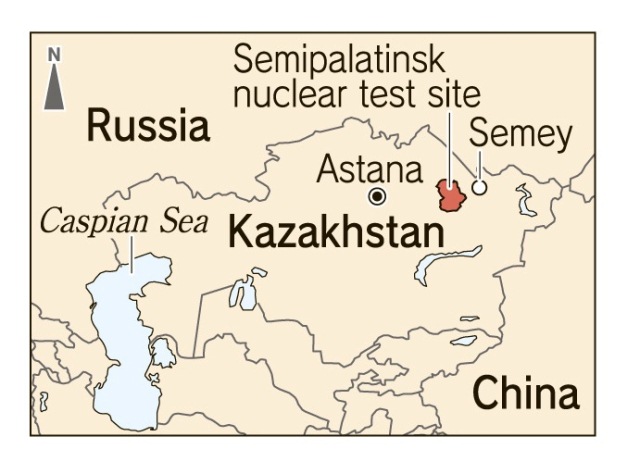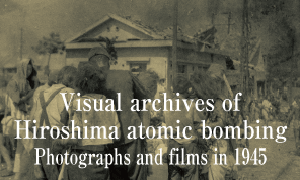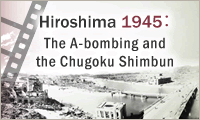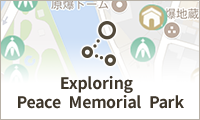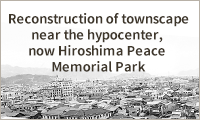Hiroshima Semipalatinsk Project marks its 20th year of support for victims of radiation exposure
Jan. 9, 2014
by Sakiko Masuda, Staff Writer
The Hiroshima Semipalatinsk Project, a citizens’ group engaged in providing support to victims of radiation exposure as a result of nuclear tests conducted in Kazakhstan, was born 20 years ago when the Asian Games were held in Hiroshima. This sports event became the impetus for the group’s founding. Currently headed by Keiichi Sasaki, the Hiroshima Semipalantinsk Project, commonly known as “Hirosemi,” is planning to pursue further exchanges with youth in Kazakhstan and provide medical aid to commemorate the 20th year of its establishment.
This summer, for the first time, the group will bring young people from Kazakhstan to Fukushima Prefecture, which suffered the March 2011 accident at the nuclear power plant there, to take part in an exchange with local Japanese youth. The group will arrange opportunities for young people from three places of nuclear damage--Kazakhstan, Fukushima, and the A-bombed city of Hiroshima--to discuss nuclear issues and nuclear energy.
Around August 29, the day the Semipalatinsk nuclear test site, the largest nuclear test site maintained by the former Soviet Union, was closed in 1991, members of the group will visit Semey (formerly Semipalatinsk) and other cities in Kazakhstan. They plan to visit a children’s hospital in the city to donate medical supplies for patients suffering from leukemia. The number of leukemia patients reportedly continues to grow around the former nuclear test site.
The group will also offer seeds and seedlings from A-bomb trees in cooperation such organizations as Green Legacy Hiroshima, a Hiroshima-based citizens’ group, in connection with a new peace museum in Semey that is planned to open in a few years.
Chieko Kobatake, 61, the vice chair of the group and a resident of Naka Ward, said, “We see the 20th benchmark year as a good opportunity to promote our exchange activities. To realize a world without nuclear weapons, we would like to lend our support to the young people of the next generation so they can work together with one another.”
Keywords
Hiroshima Semipalatinsk Project (“Hirosemi”)
The Hiroshima Semipalatinsk Project is a Hiroshima-based citizen’s group which provides a variety of support to the citizens of Kazakhstan through its exchange programs. This support includes medical assistance for the victims of radiation exposure as a result of the repeated nuclear testing carried out during the era of the former Soviet Union, and support for Kazakh students studying in Hiroshima. The group was established in 1998, spearheaded by citizens living near the Suzugamine community center in Nishi Ward. In conjunction with the Asian Games held in Hiroshima in 1994, community centers in the city of Hiroshima and residents living near these centers organized a program of support called “One Center for One Country Support Activities.” This effort led the participants to form the Hiroshima Semipalatinsk Project.
(Originally published on January 6, 2014)
The Hiroshima Semipalatinsk Project, a citizens’ group engaged in providing support to victims of radiation exposure as a result of nuclear tests conducted in Kazakhstan, was born 20 years ago when the Asian Games were held in Hiroshima. This sports event became the impetus for the group’s founding. Currently headed by Keiichi Sasaki, the Hiroshima Semipalantinsk Project, commonly known as “Hirosemi,” is planning to pursue further exchanges with youth in Kazakhstan and provide medical aid to commemorate the 20th year of its establishment.
This summer, for the first time, the group will bring young people from Kazakhstan to Fukushima Prefecture, which suffered the March 2011 accident at the nuclear power plant there, to take part in an exchange with local Japanese youth. The group will arrange opportunities for young people from three places of nuclear damage--Kazakhstan, Fukushima, and the A-bombed city of Hiroshima--to discuss nuclear issues and nuclear energy.
Around August 29, the day the Semipalatinsk nuclear test site, the largest nuclear test site maintained by the former Soviet Union, was closed in 1991, members of the group will visit Semey (formerly Semipalatinsk) and other cities in Kazakhstan. They plan to visit a children’s hospital in the city to donate medical supplies for patients suffering from leukemia. The number of leukemia patients reportedly continues to grow around the former nuclear test site.
The group will also offer seeds and seedlings from A-bomb trees in cooperation such organizations as Green Legacy Hiroshima, a Hiroshima-based citizens’ group, in connection with a new peace museum in Semey that is planned to open in a few years.
Chieko Kobatake, 61, the vice chair of the group and a resident of Naka Ward, said, “We see the 20th benchmark year as a good opportunity to promote our exchange activities. To realize a world without nuclear weapons, we would like to lend our support to the young people of the next generation so they can work together with one another.”
Keywords
Hiroshima Semipalatinsk Project (“Hirosemi”)
The Hiroshima Semipalatinsk Project is a Hiroshima-based citizen’s group which provides a variety of support to the citizens of Kazakhstan through its exchange programs. This support includes medical assistance for the victims of radiation exposure as a result of the repeated nuclear testing carried out during the era of the former Soviet Union, and support for Kazakh students studying in Hiroshima. The group was established in 1998, spearheaded by citizens living near the Suzugamine community center in Nishi Ward. In conjunction with the Asian Games held in Hiroshima in 1994, community centers in the city of Hiroshima and residents living near these centers organized a program of support called “One Center for One Country Support Activities.” This effort led the participants to form the Hiroshima Semipalatinsk Project.
(Originally published on January 6, 2014)

